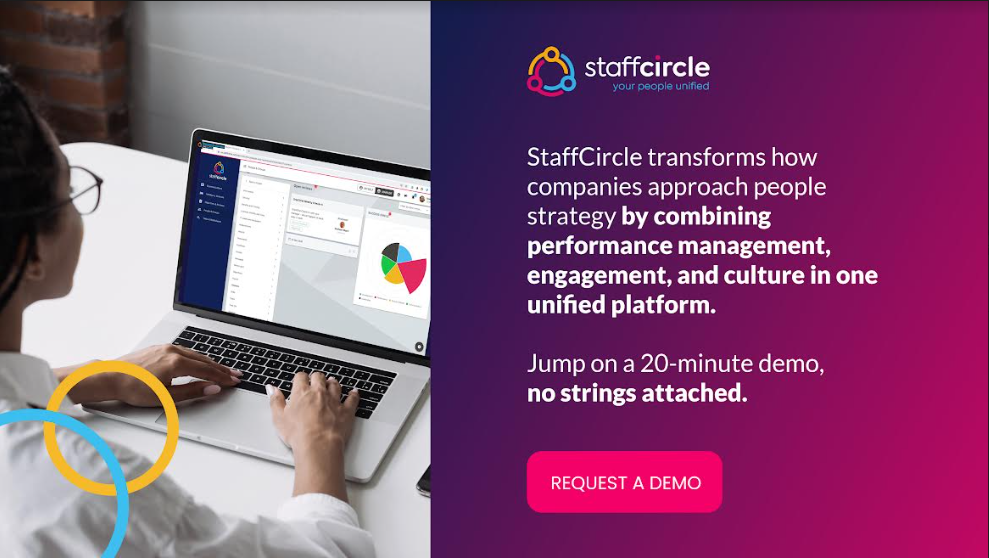Embracing the digital age: choosing the right e performance management system for your business
Choosing the right online performance management system for your company’s needs can seem like an overwhelming task. Business leaders need to consider a wide range of factors, from the size of their company to the goals and ambitions they wish to achieve. This guide will help you to break down the key factors to consider when choosing the right e-performance management system for your organization.
What is e performance management system?
Traditional performance management allows HR leaders and managers to set and track goals throughout the company and monitor for real-time feedback. Adopting e performance management systems allows businesses to improve the overall effectiveness of their workforce without the constraints of an internal management platform. With many companies adopting a hybrid working model, e performance management systems bridge the digital divide and connect employees wherever they are based.
What are the five steps in the performance management process?
Understanding the key steps to performance management is the first step to choosing the best e performance management system for your business. The five steps are:
- Planning. Understand the employee’s job description, then set goals and objectives which align their performance with the company’s overall strategy.
- Monitoring. Put in place the necessary tools and methods to track performance and flag any issues which arise in real-time.
- Reviewing. Conduct regular one2one sessions and appraisals with staff to assess overall performance.
- Improving. Create a plan of action to address any performance issues, drive coaching and training, and motivate employees to improve in the future.
- Measurement. Collect the necessary data to ensure that performance-related decisions are based on good information.
What are the benefits of e performance appraisal?
The traditional paper-and-pencil method of performance appraisals no longer delivers the required results. Using an e performance appraisal process allows managers and HR leaders to utilize intelligent software solutions, scheduling and conducting appraisals for a hybrid workforce.
Understand the organization’s structure
Understanding the structure of your organization is the first step necessary towards choosing an e performance management system. Identifying the various departments and teams, as well as the overall number of employees whose performance you wish to improve, will help determine which system to adopt.
Performance management techniques may vary depending on the function of the employee in question. Driving the sales department to new record figures may need managers and team leaders to approach performance management differently compared to research and development. Some departments or roles might require comparatively little performance management attention.
Understanding this structure will help business leaders to determine the scope required from their performance management software. Employees working remotely or on a hybrid working model, as well as contractors and freelancers, should also be considered. Likewise, if you’re planning on scaling up operations, you’ll need to factor in potential additional staff so you choose the right performance management system to suit a growing organization.

Define the overall vision of the company
A company’s culture is the foundation for future innovation. An entrepreneur’s job is to build the foundation.
Brian Chesky, businessman and industrial designer
Legendary management consultant Peter Drucker once observed that “culture eats strategy for breakfast”, but a good business leader understands how they are intrinsically linked. Determining the core values of your business’s culture will help to guide the strategy and vision of growth and success.
When looking for an online performance management system, you should set out where you envision your company heading in the future and the values which will guide success. You can then tailor the performance management experience to achieve these goals and align employees with a grander vision.
Set goals and determine the methods to chart progress
When choosing the right e performance management system, business and HR leaders need to first determine which goals they wish to achieve and how they intend to measure progress. These goals will then be inputted into the e- performance management system so that managers, team leaders and the relevant employees can track and update them in real-time.
Performance management tools will help managers and employees:
- Align their goals with the company’s strategic vision, enhancing performance by bringing an additional layer of motivation.
- Spotlight areas for concern as soon as they arise, allowing managers and employees to nip them in the bud before they cause serious issues.
- Measure – and fine-tune – progress, by framing goals and expectations through objectives and key results (OKRs) and key performance indicators (KPIs).
- Visualize progress made in a variety of easy to understand ways, for instance yes/no indicators or percentage of assignment completed.
- Apply goals and objectives to teams as well as individuals. Progress at the group level can be tracked as easily as for the sole employee.
An effective e performance management system will allow users to set goals at all levels. Short term goals and ambitious long term stretch goals can all be tracked and updated in real-time. The multi-channel communications provided by comprehensive performance management tools means that employees can stay up to date on their progress whether working from home, in the office or off-site.
Check for compatibility and integration with other business tools
If you already have systems in place your employees are familiar with, choosing an e performance management system that offers integrations is worth considering. This can help reduce the number of applications staff need to access and streamline their workflow.
Some of the best performance management tools allow users to integrate and synchronize the platform with:
Microsoft Office 365
A staple platform found in most offices, this is an essential tool to consider integrating into a performance management system.
Onelogin
OneLogin allows companies to streamline employee access while also maximizing security with two-factor authentication.
ADP Workforce Now
ADP Workforce Now offers businesses the tools to integrate internal communications, culture and performance management.
Microsoft Teams
One of the most popular collaboration tools in the world, Microsoft Teams integration with performance management systems opens up new avenues for individuals and teams to share new ideas and collaborate.
Opt for a performance management system with integrated HR tools
Managing performance is intrinsically linked to the human resources department. Managers and HR leaders frequently collaborate when it comes to hiring and firing decisions, with the latter relying on the former’s knowledge of the organization to assist with lateral promotions.
The article from McKinsey, The New Possible: How HR can help build the organization of the future, outlines how business leaders can leverage HR to drive the best outcomes. A dynamic approach to identifying and driving talent requires a greater network of influences with an emphasis on identity, agility and scalability.
“To enable this shift, HR should manage talent rigorously by building an analytics capability to mine data to hire, develop, and retain the best employees. HR business partners, who articulate these staffing needs to the executive management team, should consider themselves internal service providers that ensure high returns on human-capital investments. For example, to engage business leaders in a regular review of talent, they can develop semiautomated data dashboards that track the most important metrics for critical roles.”
When looking for an online performance management system that features HR administration, there are a range of tools that fulfil these needs, including:
- Onboarding and offboarding worksheets
- Holiday/sickness booking
- People databases
- Organization and department charts
- Timeline of employee activity
- Policy and documentation archiving
- Employee analytics and reports
HR members can view any data they wish to see via intuitive dashboards, making their roles more streamlined and efficient.
Choose a user-friendly performance management system
When introducing new software and tools to the workforce it is important to make sure the product you choose is user-friendly. Simple to use features combined with an intuitive interface allows for smooth adoption and avoids wasting valuable time getting everyone set up.
Some features you should look out for when choosing the right e performance management system include:
Branding
A performance management system provides an ideal backdrop on which your company’s culture and values can be reinforced. Performance management tools allow users to add their own customized branding, for instance, company logos and slogans. By putting these front and centre employees are consistently exposed to the organization’s core values whenever they log on.
Social and news feeds
Social media tech giants such as Facebook and Twitter have made the news feed a ubiquitous aspect of the digital world. The best e performance management systems integrate the news feeds feature into their platform to help deliver an employee experience that is familiar and intuitive. Such feeds drive culture, deliver important updates across the company and encourage higher levels of employee engagement.
Customizable dashboards
The best e performance management systems allow users to set up customizable visual dashboards. These dashboards can be tailored to display a wide range of information, including upcoming goals and objectives and any scheduled meetings or reviews/appraisals. They can also display attendance and absence data, so HR leaders can view patterns of absence at the individual, team and departmental levels.
Supercharge performance management with real-time reports and data analytics
There were 5 exabytes of information created between the dawn of civilization through 2003, but that much information is now created every two days.
Eric Schmidt, Executive Chairman at Google
Josh Bersin’s article, People Analytics and AI in the Workplace, outlines the incredible rise in data collection and analytics in the workplace. The digital age has created a scenario in which data exists for all manner of factors, allowing for incredibly nuanced approaches to people analytics.
“In the early days of HR analytics, companies captured employee data to measure span of control, the distribution of performance ratings, succession pipeline, and other talent-related topics. Today, with all this new information entering the workplace (virtually everywhere you click at work is stored somewhere), the domain of people analytics is getting very personal.”
A comprehensive digital performance management system helps leaders drive the right data required to make the best business decisions. It can be easy to become overwhelmed when data is gathered indiscriminately, so performance management with data analytics is crucial. Setting customized reports makes sure the data is filtered so that only the information which matters is presented in the reporting.
Choose the e performance management system which best suits your budget
Finally, once you’ve determined the requirements of your organization, it’s time to determine the budget to match these needs.
Do you need to implement your e performance management system throughout the entire company? Or would you prefer to focus on key departments, for example, those responsible for rolling out a new product or service? Does the performance management suite come complete with all the features and integrations you need to get the job done?
Performance management systems sometimes offer a range of modules depending on your company’s requirements. Performance management modules complemented with comms and culture tools may well suffice. However, you may feel that adding an additional module covering HR administrative tools is necessary to give your organization the complete and fully integrated performance management experience.
Use a price calculator
Some performance management tool developers include a handy pricing calculator, which takes into account your organization’s size, average salary, employee turnover rate and the number of intended users. These calculators are a great way of making a quick determination as to the overall value of choosing the right e performance management system.
Request a demo
Nothing beats getting hands-on experience with the product you’re considering investing time and money in. This is as true for e performance management systems as it is anything else, so whenever possible you should request a demo. This is a great way to clarify the ins and outs of the e performance management system you’re considering. It will also give you an opportunity to raise any questions you have with their support team before taking the plunge.



